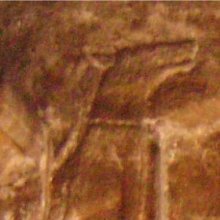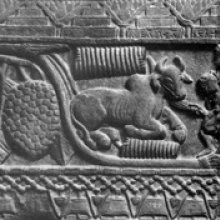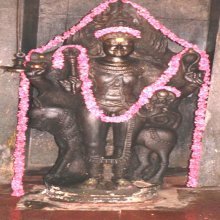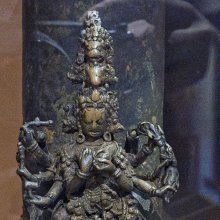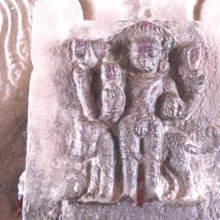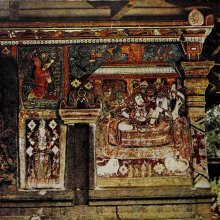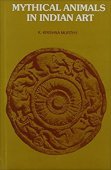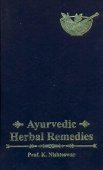Dog: 2 definitions
Introduction:
Dog means something in Buddhism, Pali, Hinduism, Sanskrit. If you want to know the exact meaning, history, etymology or English translation of this term then check out the descriptions on this page. Add your comment or reference to a book if you want to contribute to this summary article.
Images (photo gallery)
In Hinduism
Ayurveda (science of life)
Toxicology (Study and Treatment of poison)
Source: Shodhganga: Kasyapa Samhita—Text on Visha ChikitsaThe study of Dogs (habitat, infections and treatment) is dealt with in the Kāśyapa Saṃhitā: an ancient Sanskrit text from the Pāñcarātra tradition dealing with both Tantra and Viṣacikitsā—an important topic from Āyurveda which deals with the study of Toxicology (Viṣavidyā or Sarpavidyā).—The twelfth adhyāya of the Kāśyapasaṃhitā consisting sixty-six verses dwells upon twenty kinds of venom and the treatment administered therein. Verses (1-42) discuss at length, various species like [e.g., dogs], their sub-varieties, the infection caused by their bite or sting and the appropriate eight types of effective medication like treating thirst, incision, removal of excess water content, ablutions, medicated drinks, liniments and nasal sprays to be administered for curing the same

Āyurveda (आयुर्वेद, ayurveda) is a branch of Indian science dealing with medicine, herbalism, taxology, anatomy, surgery, alchemy and related topics. Traditional practice of Āyurveda in ancient India dates back to at least the first millenium BC. Literature is commonly written in Sanskrit using various poetic metres.
In Buddhism
Tibetan Buddhism (Vajrayana or tantric Buddhism)
Source: academia.edu: The Structure and Meanings of the Heruka MaṇḍalaThe Dog (animal) is associated with the Yoginī (female deity) named Śvānī, being situated in the Medinīcakra, according to the 10th century Ḍākārṇava-tantra: one of the last Tibetan Tantric scriptures belonging to the Buddhist Saṃvara tradition consisting of 51 chapters.—Accordingly, the medinīcakra refers to one of the three divisions of the dharma-puṭa (‘dharma layer’), situated in the Herukamaṇḍala. The 36 pairs of Ḍākinīs [viz., Śvānī] and Vīras are yellow in color; the shapes of their faces are in accordance with their names [e.g., Dog]; they have four arms; they hold a skull bowl, a skull staff, a small drum, and a knife.

Tibetan Buddhism includes schools such as Nyingma, Kadampa, Kagyu and Gelug. Their primary canon of literature is divided in two broad categories: The Kangyur, which consists of Buddha’s words, and the Tengyur, which includes commentaries from various sources. Esotericism and tantra techniques (vajrayāna) are collected indepently.
See also (Relevant definitions)
Starts with (+97): Dog almond, Dog apple, Dog balls, Dog bamboo, Dog bane, Dog blood, Dog button, Dog chilli, Dog daisy, Dog fescue, Dog fruit, Dog grass, Dog mint, Dog mustard, Dog plum, Dog senna, Dog tail, Dog tooth, Dog-fennel, Dog-hobble.
Ends with: Andog, Gadog, Kraaldog, Man-biting dog, Ngologdog, Soh-myndog, Tchiendog.
Full-text (+1117): Kukkura, Sarameya, Alarka, Shvaganika, Shvana, Shvapaca, Shvakridin, Bhasaka, Shuni, Ratanduka, Mrigarati, Vrikarati, Shavakamya, Gramasimha, Jukuta, Shvan, Chu, Shunaka, Shvagana, Shvapada.
Relevant text
Search found 271 books and stories containing Dog; (plurals include: Dogs). You can also click to the full overview containing English textual excerpts. Below are direct links for the most relevant articles:
Parables of Rama (by Swami Rama Tirtha)
Story 33 - The World, a Mirror-House < [Chapter VI - Ignorance]
Story 146 - Rest and Unrest < [Chapter XXIII - Sufferings]
Story 97 - The True Neighbour < [Chapter XIV - Oneness]
A Collection of Popular Tales from the Norse and North German (by Peter Christian Asbjørsen)
Chandogya Upanishad (Shankara Bhashya) (by Ganganatha Jha)
Section 1.12 (twelfth khaṇḍa) (five texts) < [Chapter 1 - First Adhyāya]
Section 5.2 (second khaṇḍa) (eight texts) < [Chapter 5 - Fifth Adhyāya]
Section 5.10 (tenth khaṇḍa) (ten texts) < [Chapter 5 - Fifth Adhyāya]
“Flush” - Co-Consciousness < [January – March, 1985]
This Thing Called Love < [December 1938]
Phrase and Fable < [July – September, 1979]
The Jataka tales [English], Volume 1-6 (by Robert Chalmers)
Jataka 22: Kukkura-jātaka < [Book I - Ekanipāta]
Jataka 242: Sunakha-jātaka < [Book II - Dukanipāta]
Jataka 27: Abhiṇha-jātaka < [Book I - Ekanipāta]
Manusmriti with the Commentary of Medhatithi (by Ganganatha Jha)
Verse 5.129 < [Section XIII - Purification of Substances]
Verse 4.216 < [Section XIV - Other Duties]
Verse 4.115 < [Section XIII - Days unfit for Study]
Related products
